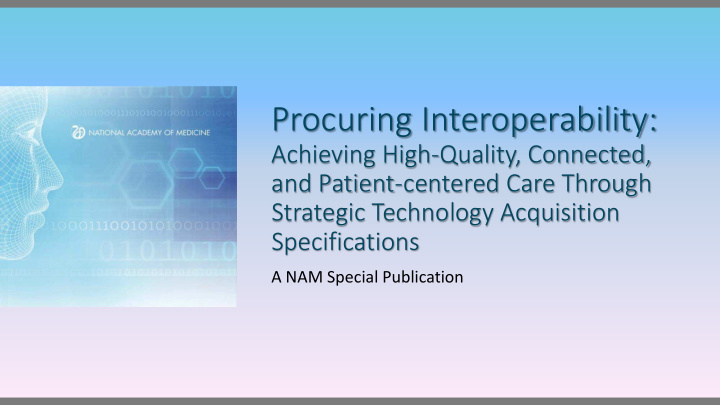



Procuring Interoperability: Achieving High-Quality, Connected, and Patient-centered Care Through Strategic Technology Acquisition Specifications A NAM Special Publication
Report background, organization, and action priorities Peter Pronovost, MD, PhD, FCCM Johns Hopkins Medicine
Authors rs Peter Pronovost, MD, PhD, FCCM, Johns Hopkins Medicine Sezin Palmer, MS, Johns Hopkins University Applied Physics Laboratory Michael M. E. Johns, MD, Emory University and Center for Medical Interoperability Meredith Alger, Center for Medical Interoperability Douglas B. Fridsma, MD, PhD, FACMI, American Medical Informatics Association Raquel C. Bono, MD, Defense Health Agency, U.S. Department of Defense William Johnson, MS , U.S. Navy (retired), WMJ Associates Craig Samitt, MD, MBA, Anthem Inc. Jennifer Lee, MD, U.S. Department of Veterans Affairs (former) Ram D. Sriram, PhD, National Institute of Standards and Technology (NIST) Andrew Gettinger, MD, Office of the National Coordinator for Health Information Technology, U.S. Department of Health and Human Services Marianne Lopez-Hamilton, PhD , National Academy of Medicine (former) Y. Claire Wang, MD, ScD, National Academy of Medicine
Bac ackg kground Medical errors result in as many as three million preventable adverse events each year, costing as much as $17 billion in excess annual medical costs Several of the most common causes of medical errors (drug, diagnostic and failure to prevent injury) can be directly addressed Preventable medical harm: by better exchange of data between patients, medical Over 100,000 lives, in the U.S. alone. devices, EMRs and other health technology
Bac ackg kground The lack of interoperability imposes a substantial burden on care providers, contributing to staff burnout and tremendous waste Documentation, manually entering readings from devices into charts, and manually programming devices accounts for over 1/3 of a hospital nurse’s time Enhancing automatic and seamless exchanges of data can immensely increase productivity while positively affecting other measures as well, including patient safety
How D w Do We Move T Toward Interoperable System ems f for or He Healthcare? e? Desire is for modular, open architecture systems Purchasers must take control of their destiny and require interoperability through procurement specifications Requires a shared vision and consistency to ensure end state is truly open Will hear from other industries including the Department of Defense about transforming the way they procure systems to drive this change
Three Tiers of I Interoperability Macro—tier: National, Regional Health Information Exchanges • Inter-facility State, Local Health Depts. • exchange Radiological, Lab Services • Commercial Pharmacy • Payers • Meso—tier: Hospital, Clinic Electronic Health Record • Medical Specialty-specific IT systems (e.g. PACS) • Administrative IT • Intra-facility exchange Micro—tier: Point-of-care Point-of-care devices, software • Wearables •
Three Tiers of I Interoperability Macro—tier: National, Regional Health Information Exchanges • Inter-facility State, Local Health Depts. • exchange Radiological, Lab Services • Commercial Pharmacy • Payers • Intra-facility exchange
Three Tiers of I Interoperability Meso—tier: Hospital, Clinic Inter-facility exchange Electronic Health Record • Medical Specialty-specific IT systems (e.g. PACS) • Administrative IT • Intra-facility exchange
Three Tiers of I Interoperability Micro—tier: Point-of-care Point-of-care devices, software • Inter-facility Wearables • exchange Intra-facility exchange
Dr Driving I g Interoperability In other industries, investments in technology and interoperability improved quality and productivity The purchasers of technologies drive interoperability through procurement contracts Healthcare could further use procurement to advance interoperability and improve quality and productivity
Action on Prior orities es Declare interoperability as a primary organizational priority; form an Commit Interoperability Steering Group; develop a roadmap and champion acquisition strategy. Identify the set of interoperability goals and requirements for the Identify procurement process to deliver on organizational priorities and patient outcome goals. Create a multi-institutional strategy to develop and align on common Collaborate contracting requirements to move toward the next generation of interoperable systems. Use specifications to state clear interoperability requirements in existing Specify and future request for proposals and contracts. Establish and monitor short-term and long-term metrics for performance Assess to advance system-wide learning and improvement.
Technical Supplement Sezin Palmer, Johns Hopkins Applied Physics Laboratory
App pproach ach Technical Technical Technical Technical Supplement A: Supplement B: Supplement C: Supplement D: Overarching Approach to Examples of Case Studies Framework Identifying Interoperability Requirements Specification Language
Approach – Ov Overar arch ching Fram amework Interoperability Steering Group Long-range Interoperability Roadmap Interoperability Needs Identification Process Procurement Specification Process
Inter erop oper erability Steering g Gr Grou oup Decision-making body to guide procurement including interoperability-related requirements and specifications Advocates and facilitates interoperability and open architecture improvements across healthcare information systems and medical devices Defines interoperability requirements, writes specification language for procurement documents Organizational champion that motivates and executes procurement framework to achieve interoperability
Long-Rang nge Interoperability Roadmap Multi-year plan that includes incremental objectives for improving interoperability Establishes milestones for planned development and procurement to move the organization toward the vision Develops roadmap through engagements with stakeholders Roadmap shared broadly within the healthcare organization; updated at least annually
Inter erop oper erability Ne Need eds Iden entification on P Proc ocess Documentation of interoperability-related needs Many approaches available – focused on N-squared diagram Used to represent interfaces and interactions between systems, people, etc. Systematic way to identify and define interfaces – and interface requirements – based on information and workflow interactions in the healthcare setting Can capture numerous interacting entities and dynamic processes
Proc ocurem emen ent Spec ecification on P Proc oces ess Translation of needs to procurement specifications to include in requests for proposals Provides requirements for implementation of specified interfaces between technologies Data exchange standards and how they are to be implemented must be defined Leverage existing processes and tools (e.g. ONC/HIT’s Interoperability Standards Advisory guidance – identifies best- practices on data exchange standards, implementation guides and integration profiles
Recomme mmendations Purchasers take control Think long-term; Ensure specific Ensure long-term – require interoperable leverage resources to language that defines commitment to vision is solutions establish standards for requirements for embraced across the data exchange among interoperability and organization; requires digital systems with end data exchange standard strong leadership to see state in mind to be used and it through implemented is included in RFPs
Recommend
More recommend